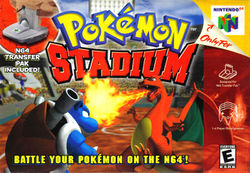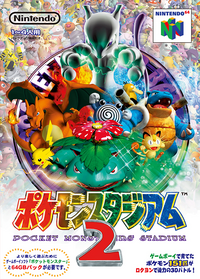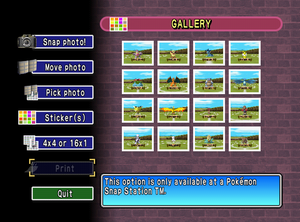Pokémon Stadium
| Pokémon Stadium ポケモンスタジアム2 | |
|---|---|
 Boxart of Pokémon Stadium | |
Basic info
| |
| Platform: | Nintendo 64 |
| Category: | Battle Simulation |
| Players: | 1-4 |
| Connectivity: | Transfer Pak |
| Developer: | Nintendo, HAL Laboratory |
| Publisher: | Nintendo |
| Part of: | Generation I side series |
Ratings
| |
| CERO: | N/A |
| ESRB: | E |
| ACB: | G |
| OFLC: | G8+ |
| PEGI: | 3 |
| GRAC: | N/A |
| GSRR: | N/A |
Release dates
| |
| Japan: | April 30, 1999[1] |
| North America: | February 29, 2000[2] |
| Australia: | March 23, 2000[3] |
| Europe: | April 7, 2000[4] |
| South Korea: | N/A |
| Hong Kong: | N/A |
| Taiwan: | N/A |
Websites
| |
| Japanese: | Pokémon.co.jp Nintendo.co.jp |
| English: | Pokémon.com (US) Pokémon.com (UK) Nintendo.com Nintendo.co.uk |
|
Japanese boxart
| |
Pokémon Stadium (Japanese, title: ポケモンスタジアム2 Pokémon Stadium 2, English subtitle: Pocket Monsters' Stadium 2) is a Nintendo 64 game that allows players to upload and battle their Pokémon from the first generation Pokémon games, Pokémon Red, Blue, Yellow, and Green in Japan. It features several battle arenas, introducing Stadium Mode's original four cups, the Pika Cup, Petit Cup, Poké Cup, and Prime Cup, the latter two of which would return in the sequel, and the original Gym Leader Castle. It also features new Pokémon cries, a feature that was carried on in the sequel for Pokémon from Generation II.
It was released in Japan on April 30, 1999, in North America on February 29, 2000, in Australia on March 23, 2000, and in Europe on April 7, 2000.
This game is the sequel to the mostly incomplete original, which was never released anywhere outside Japan.
Blurb
The ultimate Pokémon battle is about to begin...
At long last, all of your favorite Pokémon are ready to go head-to-head on the N64! Whether you're battling a friend, a Gym Leader or a tournament contestant, you're about to witness some of the most spectacular battle scenes in history! Select a team from a huge stable of "rental" battlers, or use the included N64 Transfer Pack to upload your own team from Pokémon Red, Blue or Yellow! This stadium is packed and ready to rock!
Game modes
Free battle
An open battle mode where players can battle with each other or the CPU with their favorite Pokémon. Players can use the Stadium rulesets (plus the available rentals), or choose "Anything Goes" for only the basic rules with no level limit.
Exclusive to Anything Goes is the ability to bring any number of Pokémon from one to six into battle, and play team matches with 3 or 4 players. When two players are on a given side, each selects up to 3 Pokémon to control.
Stadium
- Main article: Stadium Mode
This is the main game mode. There are four different cup rules to win; Pika Cup, Petit Cup, Poké Cup, and Prime Cup. In the latter two, there are four levels of difficulty; Poké Ball, Great Ball, Ultra Ball and Master Ball.
Gym Leader Castle
- Main article: Gym Leader Castle
In this mode, the goal is to climb to the castle's top by facing, in order, all 8 Gym Leaders from Kanto, followed by the Elite 4, and finally the player's rival. Each of the Gym Leaders has 3 apprentices that the player must defeat first in order to battle the Gym Leader themselves.
When the rival is finally defeated, the player will be rewarded one of the following 8 Pokémon at random, each of them uncommon in Generation I and usually only available once in a particular Game Boy game without trading. The starters are at level 5, the Fossil and Dojo Pokémon are at level 20, and Eevee is at level 25.
| ||||||||||||||||||||||||||||||||||||||||
Battle Now!
In this mode, the player can play a battle without having to select Pokémon. Rather, the players are randomly assigned one of two predetermined teams.
Round 1
|
|||||||||||||||||||||||||||||||||||||||||||||||||||||||||||||||||||||||||||||||||||||||||||||||||||||||||||||||||||||||||||||||||
| |||||||||||||||||||||||||||||||||||||||||||||||||||||||||||||||||||||||||||||||||||||||||||||||||||||||||||||||||||||||||||||||||
|
|||||||||||||||||||||||||||||||||||||||||||||||||||||||||||||||||||||||||||||||||||||||||||||||||||||||||||||||||||||||||||||||||
| |||||||||||||||||||||||||||||||||||||||||||||||||||||||||||||||||||||||||||||||||||||||||||||||||||||||||||||||||||||||||||||||||
Round 2
|
|||||||||||||||||||||||||||||||||||||||||||||||||||||||||||||||||||||||||||||||||||||||||||||||||||||||||||||||||||||||||||||||||||
| |||||||||||||||||||||||||||||||||||||||||||||||||||||||||||||||||||||||||||||||||||||||||||||||||||||||||||||||||||||||||||||||||||
|
|||||||||||||||||||||||||||||||||||||||||||||||||||||||||||||||||||||||||||||||||||||||||||||||||||||||||||||||||||||||||||||||||||||||
| |||||||||||||||||||||||||||||||||||||||||||||||||||||||||||||||||||||||||||||||||||||||||||||||||||||||||||||||||||||||||||||||||||||||
Vs. Mewtwo
Once the player has completed the Stadium Mode and Gym Leader Castle, Mewtwo's silhouette will appear in the sky over the Stadium for selection. This is simply a showdown against Mewtwo itself, under essentially "Anything Goes" rules: up to six Pokémon (the player's own or Prime Cup rentals) can be brought to the battle, but Mewtwo is the only opponent. It has infinite PP.
Defeating Mewtwo launches the credits, changes the title screen and unlocks Round 2. Re-unlocking and defeating Mewtwo in Round 2 (where its stats are increased to the max) awards special hidden stickers available in the Gallery mode.
| Round 1 | Round 2 | |||||||||||||||||||||||||||||||||||||||||||||||||||||||||||||||||
|---|---|---|---|---|---|---|---|---|---|---|---|---|---|---|---|---|---|---|---|---|---|---|---|---|---|---|---|---|---|---|---|---|---|---|---|---|---|---|---|---|---|---|---|---|---|---|---|---|---|---|---|---|---|---|---|---|---|---|---|---|---|---|---|---|---|---|
|
| |||||||||||||||||||||||||||||||||||||||||||||||||||||||||||||||||
Kids Club
- Main article: Pokémon Stadium series mini-games#In Pokémon Stadium
The Kids Club area is home to nine different mini-games, which may be played with one to four human players (the remaining players are controlled by the computer).
Gallery
This feature, which only exists in the North American version of the game, is used to take pictures of Pokémon from a Red, Blue, or Yellow cartridge inserted into the Transfer Pak or any rental Pokémon. Any of the game's arenas can be selected for a backdrop and the photos are stored in an in-game album. These pictures can be printed out as stickers (in 16×1 or 4×4 sizes) via the same Sticker Station that was used for Pokémon Snap.
Oak's Lab
This can only be used if the player has a copy of Pokémon Red, Blue or Yellow inserted into a Transfer Pak. Here, the player can access boxes to organize and store Pokémon and items, trade Pokémon between game cartridges (with two Transfer Paks), and accept prize Pokémon won elsewhere in the game. Using this feature will cause any Pokémon above level 100 (obtained either by hacking or via the Old man glitch) to be permanently reverted to level 100.
GB Tower
This is used to play an emulated version of Red, Blue, or Yellow on the Nintendo 64. Different borders can be applied, some exclusive to particular versions. In addition, a Doduo Game Boy Tower can be unlocked by completing either the Poké Cup or Prime Cup in Round 1, which allows the game to be played at double the speed. A Dodrio Game Boy Tower can also be unlocked by beating both the Poké Cup and Prime Cup in Round 1, allowing the game to be played at triple speed.
Hall of Fame
When the player clears the final division of a Stadium Cup or defeats the Rival in the Gym Leader Castle, all of the Pokémon on the player's team will be registered in the Hall of Fame.
Round 2
When the Vs. Mewtwo battle is cleared, Round 2 can be toggled on and off by pressing C-Right on the main menu. Round 2 challenges the player to battle through the game all over again, against the same opponents with different Pokémon and a much higher difficulty. Mew can also be rented in the Prime Cup. The surrounding Stadium area in Round 2 is set at night.
Changes
Trainer class changes
As there is a seven-letter limit for Trainer names, some Trainer classes go by different names.
|
Game mechanic changes
Pokémon Stadium features a number of changes to the battle system. Many of these fix glitches present in the Generation I core series games.[5][6]
General changes include:
- The duration of sleep is reduced to 1-3 turns.
- If a Pokémon defeats an opposing Pokémon with a recoil move, the Pokémon does not suffer recoil damage.
- An immobilized Pokémon can still select a move.
- Consecutive moves such as Wrap end when the target switches out.
- All status conditions and HP-draining moves have no effect against a substitute.
- If a Pokémon is fully paralyzed during the invulnerable turn of Dig or Fly, the move resets.
- When a paralyzed Pokémon's Speed stat is modified, its Speed reduction is no longer nullified.
- After a move which causes self-inflicted confusion (e.g. Thrash) ends, the game will display a message stating that the target is confused.
- The variable that determines the last damage dealt is reset whenever a Pokémon switches, is fully paralyzed, or uses a two-turn move.
- Recovery moves no longer fail when the difference between a Pokémon's current and maximum HP is 255 or 511.
- Critical Hit ratio is changed to
(BaseSpeed + 76) / 1024*. - The stat modifiers for accuracy and evasion were changed.
In addition, the following moves were changed:
Localization changes
Like the Generation I handheld games, Pokémon Stadium had several changes from the Japanese version.
- The Japanese version had six Stadium Cups. In addition to the Pika, Petit, and Prime Cups, there were three cups based upon official tournaments: the Nintendo Cup '97, Nintendo Cup '98, and Nintendo Cup '99. In the international versions, the Nintendo Cups were replaced with the Poké Cup from Pokémon Yellow's Colosseum 2.
- A Gallery mode was added, but only in the American version (it was still absent in PAL versions).
- Pikachu can be taught Surf under special conditions. Japanese players could teach a Pikachu Surf in the original Pokémon Stadium.
- The number of teams that could be registered was decreased from 12 to 10.
- In Clefairy Says, the Clefairy sing rather than repeat the same sound effect.
Special Pokémon
One Pokémon with a unique move can be obtained and transferred to any Generation I game.
Amnesia Psyduck
This Psyduck with the special move Amnesia is obtained by registering all 151 Pokémon in the Hall of Fame.
| Pokémon Info | Battle Moves | ||||||||||||||||||
|---|---|---|---|---|---|---|---|---|---|---|---|---|---|---|---|---|---|---|---|
| PSYDUCK | Normal | Scratch | |||||||||||||||||
| Lv. 15 | Dex No. | Psychic | Amnesia | ||||||||||||||||

|
0054 | -- | -- | ||||||||||||||||
| Type | -- | -- | |||||||||||||||||
| Water | There is no limit to this Pokémon's availability. It may be obtained on any date, beginning from when it was released. It was available in all regions. | ||||||||||||||||||
| Item | OT | スタジアム* STADIUM* | |||||||||||||||||
| Gorgeous Box* | ID No. | 01999* 02000* | |||||||||||||||||
| |||||||||||||||||||
| |||||||||||||||||||
Move Tutor
A Pikachu can be taught Surf if the player clears the Master Ball division of the Round 2 Prime Cup under the following conditions:[7][8]
- All of the Pokémon must be selected directly from a Game Pak (Pokémon cannot be registered). The Pikachu can come from any Generation I game.
- Continues may be used, but the game cannot be saved.
- Pikachu only has to be selected for the final battle, but does not have to take part in the battle.
Staff
- Main article: Staff of Pokémon Stadium (English)
Trivia
- Pokémon cries have a much more realistic sound in this game. However, the starter Pikachu from Pokémon Yellow says its name like in the anime.
- This concept was carried over to Pokémon Stadium 2.
- This was the first home console game to have all Pokémon in its generation able to be used in battle.
- Nicknamed Pokémon have slightly altered colorations when used in battle. As a result, most NPC Trainers use nicknamed Pokémon to emphasize the effect. This marks one of the few situations where NPCs have nicknamed Pokémon.
- The color alterations depend on the Pokémon's nickname and the Original Trainer's Trainer ID number and name, so even if two Trainers have Pokémon with the same nickname, the Pokémon still will not likely have the same coloration.
- Rocket's Pokémon have numbers in their nicknames, even though this was not possible until Generation III. The same applies for Team Rocket Grunts in the sequel.
- This was the first Pokémon game that allowed more than two players to battle at one time. This feature would not be implemented into the handheld games until Generation III.
- This is the only game where Lance does not use a Dragonite at any point in the game.
- Unlike handheld games, if due to glitches (like Pokémon "growing" from Lv. 255 to Lv. 0, thus lowering HP) Pokémon current HP happens to be below 0, it's shown properly (like 64569).
- Clearing the Gym Leader Castle and Prime Cup on Master Ball mode will unlock an alternate title screen.
- Although there is a 1'4" (0.4 m) difference between Nidoking and Venonat, the two appear to be the same height in battle.
- If a Pokémon knows four HM moves, using a TM in the menu allows the first move to be overwritten. This is the only way to replace HM moves in Generation I.
- Jynx's body color was changed from black to purple between the 1.0 and 1.1 English releases to avoid further controversy.
In other languages
| |||||||||||||||||||||
External links

|
This game-related article is part of Project Games, a Bulbapedia project that aims to write comprehensive articles on the Pokémon games. |








































